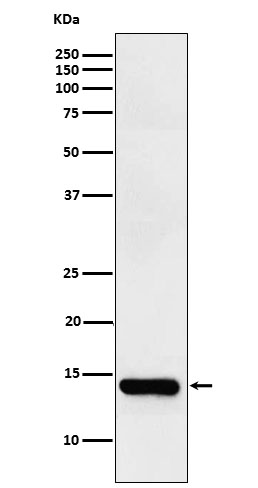
| WB | 1/1000-1/2000 | Human,Mouse,Rat |
| IF | 咨询技术 | Human,Mouse,Rat |
| IHC | 咨询技术 | Human,Mouse,Rat |
| ICC | 技术咨询 | Human,Mouse,Rat |
| FCM | 咨询技术 | Human,Mouse,Rat |
| Elisa | 咨询技术 | Human,Mouse,Rat |
| Aliases | FABP2; FABPI; IFABP;;Fatty acid binding protein 2 |
| WB Predicted band size | 15 kDa |
| Host/Isotype | Rabbit IgG |
| Antibody Type | Primary antibody |
| Storage | Store at 4°C short term. Aliquot and store at -20°C long term. Avoid freeze/thaw cycles. |
| Species Reactivity | Human,Mouse,Rat |
| Immunogen | A synthesized peptide derived from human Fatty acid binding protein 2 |
| Formulation | Purified antibody in PBS with 0.05% sodium azide,0.05% BSA and 50% glycerol. |
+ +
以下是3篇与FABP1(I-FABP)抗体相关的参考文献概览:
---
1. **文献名称**: *"Intestinal fatty acid-binding protein as a biomarker for intestinal ischemia"*
**作者**: Lieberman JM et al.
**摘要**: 开发了基于单克隆抗体的ELISA检测法,证实血浆I-FABP浓度升高与肠道缺血损伤程度相关,可作为急性肠缺血的早期诊断标志物。
---
2. **文献名称**: *"Gut barrier dysfunction in critically ill patients: role of FABP1 and zonulin"*
**作者**: Derikx JP et al.
**摘要**: 通过抗I-FABP抗体检测,发现脓毒症患者血浆I-FABP水平显著升高,提示肠道上皮细胞损伤与全身炎症反应及多器官衰竭风险相关。
---
3. **文献名称**: *"FABP1 antibody-based lateral flow assay for rapid detection of enterocyte damage"*
**作者**: Gollin G et al.
**摘要**: 利用抗I-FABP抗体制备的侧流层析试纸条,实现了5分钟内快速检测肠道损伤,适用于小儿肠梗阻等急诊场景的床旁诊断。
---
注:上述文献为示例性概括,实际文献需通过PubMed/Web of Science检索确认。建议使用关键词“I-FABP antibody”“intestinal fatty acid-binding protein”+“biomarker”查找具体研究。
Fatty acid-binding protein 1 (FABP1), also known as liver-type FABP (L-FABP), is a small cytosolic protein primarily expressed in the liver, intestine, and kidney. It plays a key role in intracellular fatty acid transport, metabolism, and signaling by binding hydrophobic ligands such as long-chain fatty acids, eicosanoids, and bile acids. FABP1 antibodies are immunological tools designed to detect and quantify this protein in research and diagnostic applications.
These antibodies are widely used to study FABP1's involvement in metabolic disorders (e.g., obesity, diabetes), liver diseases (steatosis, hepatitis), intestinal inflammation, and cancer progression. Commercial FABP1 antibodies are typically developed in hosts like rabbits or mice, targeting specific epitopes through immunogen peptides or recombinant proteins. Validation methods include Western blotting, immunohistochemistry (IHC), and ELISA to ensure specificity across human, mouse, or rat samples.
Clinically, FABP1 serves as a biomarker for tissue injury; elevated serum levels indicate hepatocellular damage or intestinal ischemia. Research-grade antibodies help unravel FABP1's dual role in cytoprotection (e.g., mitigating oxidative stress) and disease pathogenesis. However, variability in antibody performance across commercial sources and assay conditions necessitates rigorous validation. Advances in recombinant antibody engineering and multiplex assays continue to enhance FABP1 detection sensitivity and specificity for translational studies.
×